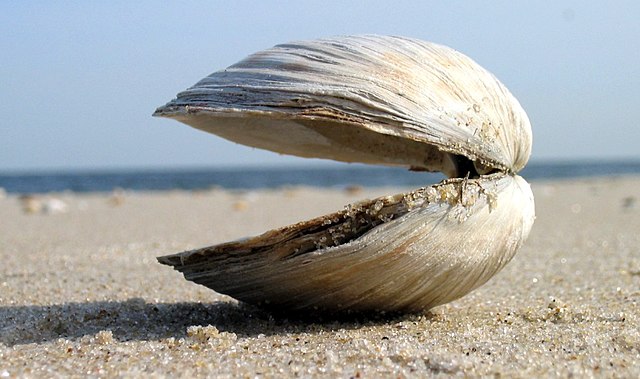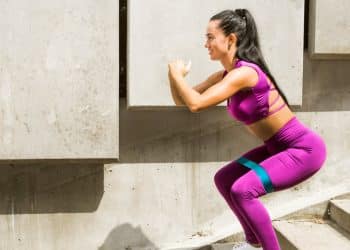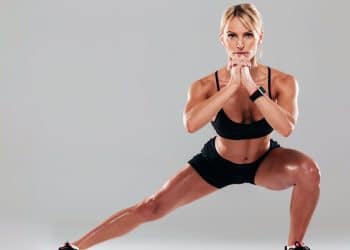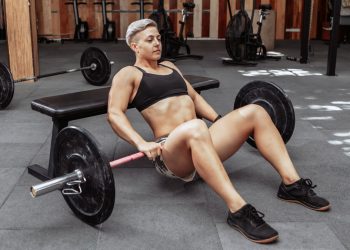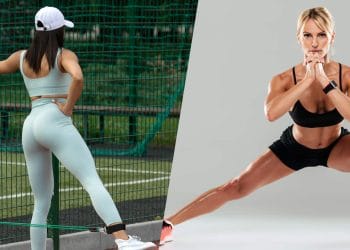Most lower body exercises involve your glutes, or they should. Unfortunately, prolonged sitting and general sedentarism mean many people suffer from something called glute amnesia, where the mind-muscle connection is very weak.
In simple terms, they’ve forgotten how to use their glutes!
While hardly life-threatening, glute amnesia can affect your workout performance and hurt your progress. Plus, having weak, underdeveloped glutes will affect how you look. Finally, glute amnesia can cause aches and pains in nearby joints, most commonly the lower back and knees.
So, it’s time to wake up your glutes!
One of the best ways to reestablish your mind-muscle connection with your glutes is the clamshell exercise. There are several additional benefits to doing clamshells, too. This simple yet effective bodyweight exercise is perfect for all fitness and experience levels.
In this article, we reveal why and how to do the clamshell exercises and share the best variations and alternatives you can use to keep your workouts varied and interesting.
Level Up Your Fitness: Join our 💪 strong community in Fitness Volt Newsletter. Get daily inspiration, expert-backed workouts, nutrition tips, the latest in strength sports, and the support you need to reach your goals. Subscribe for free!
Clamshells – Muscles Worked
Most exercises can be categorized as either compound or isolation. Compound exercises involve multiple joints and muscles working together. In contrast, isolation exercises involve one joint and considerably fewer muscles.
Because only one joint moves when you do them, clamshells are an isolation exercise. The muscles trained during the clamshell exercise are:
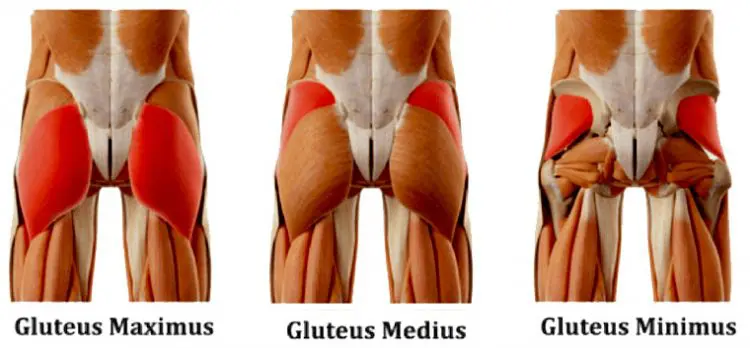
Gluteus maximus
The gluteus maximus (glute max) is the largest muscle in the human body, potentially the most powerful, and you are currently sitting on yours! It’s located on the back and side of your hip. The functions of the gluteus maximus are:
- Hip extension
- Hip lateral (external) rotation
- Hip abduction (superior or upper portion)
- Hip adduction (inferior or lower portion)
Gluteus medius
The gluteus medius is located above and beneath the glute max near the top of your pelvis. It works with the gluteus maximus but also has some additional functions:
- Hip abduction (movement away from the midline of the body)
- Hip medial (internal) rotation
- Pelvis stabilization
Gluteus minimus
The gluteus minimus is a small triangular muscle located toward the rear of your hip. Like the gluteus medius, the gluteus minimus works alongside the glute max, and its functions are:
- Hip abduction
- Hip medial rotation
- Pelvis stabilization
Tensor fascia latae
Despite not having the word gluteus in its name, the TFL is still part of the glute/hip complex. It’s a biaxial muscle, meaning it crosses and affects two joints – the hip and the knee. As part of the glute group, TFL is involved in the following movements:
- Hip internal rotation
- Hip abduction
- Pelvis stabilization
How to Do the Clamshell Exercise
Get more from clamshells while keeping your risk of injury to a minimum by following these steps:
- Lie on your side with your legs bent to 45 degrees and your ankles and knees stacked and together.
- Rest your head on your hand or outstretched arm as preferred. Place your uppermost hand on the floor in front of you for balance.
- Brace your core and initiate each rep with an inhalation. Do not lean back or allow your feet to separate once you begin.
- Keeping your feet together, lift your top knee upward. Feel an intense contraction in your glutes.
- Bring your knees back together and repeat.
- Switch sides and do the same number of reps with the other leg.
Tips:
- Pause for 1-3 seconds at the top of each rep to fully engage your glutes.
- Rest your head on a pillow or foam pad for comfort and neck support if required.
- Do not lean back so you can lift your top leg higher. This is a false indictor of an effective workout. Instead, keep your hips stacked and only lift your knee partway up.
- Place a folded exercise mat beneath your hips if necessary.
- Do this exercise with your back, butt, and feet against a wall to keep your body properly aligned like this:
Clamshell Exercise Benefits
Not sure if the clamshell exercise deserves your time and energy? Consider these benefits and then decide!
Anywhere, anytime
Looking for a glute exercise you can do whenever you want or need to? Clamshells require no equipment, so there is no barrier to performing them. As such, they’re the perfect excuse-free butt workout.
Reduce your injury risk
Suppose your hip external rotators and abductors are allowed to weaken. In that case, your knees may drop inward when you’re doing squats, lunges, or just walking or running. This puts a lot of additional stress on your hip and knee joints and can even affect your lower back.
Clamshells strengthen the muscles responsible for preventing knee caving, so doing them could help lower your risk of injury.
Improve hip mobility
The majority of leg exercises take place in the sagittal plane, i.e., forward and backward. However, the hips can move in the frontal and transverse planes, too. Clamshells let you move your hips in the latter planes which is good for overall functionality and mobility.
So, got tight hips? Then do the clamshell exercise!
Easy to learn
As glute exercises go, the clamshell exercise is pretty straightforward and easy to learn. Even complete beginners should have no problem picking up and mastering this exercise. However, don’t let this simplicity fool you; clamshells are still very effective.
Great for firing up your glutes before more demanding exercises and workouts
A long day of sitting at your desk can leave you with drowsy glutes and tight hips. Wake and loosen them up with clamshells! A couple of sets of the clamshell exercise will get your glutes firing and your hips moving so that you can perform at your best when you reach the main part of your workout. Do some clamshells during your warm-up before lower body strength and cardio workouts, especially running.
Very joint-friendly
There is very little stress on your knees, hips, or lower back during clamshells. As such, it’s ideal for exercisers who find things like squats, hip thrusts, and lunges too challenging. It’s highly unlikely that doing the clamshell exercise will lead to injuries. That said, you must still endeavor to perform this exercise with perfect technique.
Build a better butt
A lot of exercisers want a firm, tight, strong butt. They do many different exercises to achieve this goal, including lunges, hip thrusts, and hip abductions. Now you can add another move to your booty-building library – the clamshell. It’s always useful to know plenty of exercises per body part. After all, you never know when you’ll need a new move to liven up your workout.
Drawbacks
While clamshells are a mostly beneficial glute exercise, there are also a couple of drawbacks to consider:
Limited overload
If your hip abductors and external rotators are weak, lifting your own leg will probably provide an adequate workout. However, as you get stronger, your muscles will need more resistance to work against to get an effective training effect.
As such, you may need to find a more demanding alternative to this exercise quite soon. Don’t worry, though; we’ve got that covered in the next section!
Easy to cheat
It’s easy to cheat and make the clamshell easier and less effective. For example, you can lean your top hip backward so you can lift your top knee higher. The best way to make this exercise as effective as possible is to do it slowly, squeeze your glutes at the top of each rep, and keep your hips and shoulders stacked throughout. Alternatively, do the back-against-the-wall variation mentioned in the tips section above.
Non-weight bearing
You’ll rarely need to stabilize or rotate your hips in anything other than the standing position. As such, the clamshell exercise may have limited carryover to activities outside of the gym. It’s still an effective exercise, but you must also include weight-bearing exercises in your glute and hip workouts to maximize your fitness and performance.
8 Clamshell Exercise Variations and Alternatives
Clamshells are a highly effective hip and glute exercise, but that doesn’t mean you need to do them all the time. There are several variations and alternatives you can use to keep your workouts productive and interesting:
Level Up Your Fitness: Join our 💪 strong community in Fitness Volt Newsletter. Get daily inspiration, expert-backed workouts, nutrition tips, the latest in strength sports, and the support you need to reach your goals. Subscribe for free!
1. Banded clamshell exercise
If bodyweight clamshells are no longer challenging enough, you are probably ready to try the banded version. Putting a resistance band around your knees increases the overload on your muscles at the top of each rep.
Steps:
- Place a booty band around your legs, just above or below your knees.
- Lie on your side with your legs bent to 45 degrees and your ankles and knees stacked and together.
- Rest your head on your hand or outstretched arm as preferred. Place your uppermost hand on the floor in front of you for balance.
- Brace your core and initiate each rep with an inhalation. Do not lean back or allow your feet to separate once you begin.
- Keeping your feet together, lift your uppermost knee upward against the resistance offered by the band.
- Lower your knee and repeat.
- Switch sides and do the same number of reps with the other leg.
Muscles Targeted:
- Primary: Gluteus maximus, minimus, and medius.
- Secondary: Tensor fascia latae and core.
Benefits:
- A good way to overload your glutes and a convenient progression from bodyweight clamshells.
- More efficient workouts as you won’t need to do as many reps.
- Bands as highly portable, so you can do this exercise anywhere and anytime.
Tips:
- Start with a thin/narrow band – a little resistance goes a long way with this exercise.
- Rest your head on a pillow or foam pad for comfort, and place a folded exercise mat beneath your hips if required.
- You can also do this exercise with your back, butt, and feet against a wall.
2. Isotonic wall clamshell exercise
As we mentioned in the drawbacks, clamshells are not a weight-bearing exercise. As such, they may not be the best way to improve your hip strength and stability for things like running, lunges, etc. This variation involves pressing your feet against a wall, which means it’s potentially a more functional way to do the clamshell exercise.
Steps:
- Lie on your side with your legs bent to 45 degrees and the soles of your feet pressed up against a wall. Stack your ankles and knees and press them together.
- Rest your head on your hand or outstretched arm as preferred. Place your uppermost hand on the floor in front of you for balance.
- Brace your core and initiate each rep with an inhalation. Do not lean back or allow your feet to separate once you begin.
- Keeping your feet together and pressed against the wall, lift your uppermost knee upward against the resistance offered by the band.
- Lower your knee and repeat.
- Switch sides and do the same number of reps with the other leg.
Muscles Targeted:
- Primary: Gluteus maximus, minimus, and medius.
- Secondary: Tensor fascia latae and core.
Benefits:
- An excellent step up from regular clamshells.
- A more functional hip strengthening exercise than standard clamshells.
- A superb hip stability exercise for athletes, especially runners.
Tips:
- Do this exercise without a band initially, and then add a band as you get stronger.
- You can also do this exercise with your back as well as your feet against a wall using a corner.
- Place a folded exercise mat beneath your hips if necessary.
3. Weighted clamshell exercise
While resistance bands are a great tool for making your workouts harder, it’s tough to determine precisely how much more work you’re doing. Using a weight plate makes it much easier to quantify and track your progress.
Steps:
- Lie on your side with your legs bent to 45 degrees and your ankles and knees stacked and together.
- Rest your head on your hand or outstretched arm as preferred. Use your uppermost hand to hold a weight plate on your outer thigh.
- Brace your core and initiate each rep with an inhalation. Do not lean back or allow your feet to separate once you begin.
- Keeping your feet together, lift your uppermost knee upward against the resistance offered by the weight plate.
- Lower your knee and repeat.
- Switch sides and do the same number of reps with the other leg.
Muscles Targeted:
- Primary: Gluteus maximus, minimus, and medius.
- Secondary: Tensor fascia latae and core.
Benefits:
- A straightforward way to overload your muscles.
- Using weight makes it easier to track your progress.
- A good way to increase glute and hip strength.
Tips:
- Hold the weight plate firmly to stop it from sliding off your leg.
- You can also use any other type of weight available, such as an ankle weight or even a water bottle or heavy book.
- Rest your head on a cushion or foam pad for extra comfort.
4. Standing clamshell exercise
The standing clamshell is a functional exercise that challenges your balance and builds strength in both legs simultaneously. Because it’s done standing, this is an ideal clamshell exercise for increasing hip stability before a workout while maintaining your core temperature and raised heart rate.
Steps:
- Stand with your back to a wall. Bend one leg and place your foot on the wall behind you at roughly knee height. Bend your supporting leg slightly for better balance. Brace your core.
- Rotate your non-weight-bearing leg outward until you feel a strong contraction in your glutes. Turn your hips in the same direction as your knees.
- Return to your starting position and repeat.
- Do the same number of reps on both legs.
Muscles Targeted:
- Primary: Gluteus maximus, minimus, and medius.
- Secondary: Tensor fascia latae and core.
Benefits:
- A more demanding exercise than the lying variation.
- An excellent exercise for increasing hip and glute engagement in warm-ups.
- Good for athletes from all sports.
Tips:
- You can also do this exercise with a band to make it more challenging.
- Keep your supporting leg slightly bent for balance.
- You can also do this exercise away from the wall and without support – but only if your balance is good enough.
5. Side plank clamshell exercise
Most people know that side planks are an effective core exercise. However, with a few minor modifications, you can turn it into a superb glute and hip exercise. This movement is challenging, so only attempt it if you are mastered regular side planks and clamshells separately.
Steps:
- Lie on your side and rest on your forearm. Your elbow should be directly beneath your shoulder.
- Bend your legs to 90 degrees, ensuring your hips are stacked, and your ankles are together.
- Lift your hips off the floor, so your body is straight. Brace your core.
- Then, keeping your hips up, rotate your uppermost knee up and out. Keep your feet together throughout.
- Lower your knee and repeat.
- Rest a moment and then swap sides.
Muscles Targeted:
- Primary: Gluteus maximus, minimus, medius, and core.
- Secondary: Hip abductors, tensor fascia latae.
Benefits:
- An intensely challenging lower body and core exercise.
- Trains both hips at the same one, one dynamically and one isometrically.
- A great way to make boring old planks more interesting!
Tips:
- You can also do this exercise with a band around your legs.
- Keep your core braced throughout but take care not to hold your breath.
- Raise and lower your hips instead of staying in the side plank position if you wish.
6. Seated band hip abductions
The great thing about this hip and glute exercise is that it hits both sides simultaneously, saving you time and energy. Do this exercise before or between sets of squats to fire up your glutes and increase your squat performance.
Steps:
- Put a resistance band around your legs, just above or below your knees. Sit on the edge of an exercise bench with your feet flat on the floor, roughly shoulder-width apart.
- Keeping your feet stationary, press your knees out against the tension offered by the band.
- Pause with your knees apart for 2-3 seconds, then bring them back in. However, do not relax and make sure that there is still some tension in the band and, therefore, on your muscles.
- Continue for the desired number of reps.
Muscles Targeted:
- Primary: Gluteus maximus, minimus, and medius.
- Secondary: Tensor fascia latae.
Benefits:
- An ideal glute and hip warm-up exercise.
- A great exercise for gym and home exercisers.
- A perfect alternative to the hip abduction machine.
- An excellent way to wake up your glutes before lower body training.
Tips:
- The further apart you place your feet, the more stretched the band will be, and the harder your muscles will have to work.
- Sit up tall on your ischia or sitting bones to maximize hip and glute engagement.
- Use multiple bands if you need more resistance, e.g., one above and one below your knees.
7. Banded goblet squats
While working on hip abduction and external rotation in isolation can be beneficial, that’s not how these muscles usually work in nature. Instead, they contract alongside other muscles, such as your quadriceps and hamstrings. This exercise works all your lower body muscles while you continue to work on developing your hip abduction strength.
Steps:
- Place a resistance band around your legs, just above or below your knees. Step out and into a shoulder-width stance, toes turned slightly outward. Brace your core.
- Hold a kettlebell in front of your chest and just below your chin. Tuck your upper arms into your ribs and pull your shoulders down and back.
- Pressing out against the band, bend your legs and squat down until your thighs are roughly parallel to the floor. Take care not to round your lower back.
- Stand back up and repeat.
Muscles Targeted:
- Primary: Quadriceps, hamstrings, gluteus maximus, minimus, and medius.
- Secondary: Core.
Benefits:
- A very functional exercise.
- Easier to learn and master than barbell back or front squats.
- An excellent way to make your workouts more time-efficient.
Tips:
- Raise your heels on weight plates to increase squat depth and quadriceps engagement.
- You can also do this exercise with a single dumbbell.
- If weighted banded goblet squats are too challenging, feel free to do this exercise without weight.
8. Fire hydrants
Fire hydrants, which are so-called because you look like a dog peeing when you do them, are basically a kneeling clamshell exercise. Because you are lifting your leg against gravity, you may find fire hydrants a little more challenging. This is a great glute exercise, which is why it features in so many group workout programs.
Steps:
- Kneel on all fours with your hands directly under your shoulders and your knees beneath your hips. Brace your core and gently lengthen your neck.
- Keeping your shoulders and hips stationary, lift one knee up and out to the side. Keep your leg bent to 90 degrees.
- Lower your leg and repeat.
Muscles Targeted:
Primary: Gluteus maximus, minimus, and medius abductors.
Secondary: Core.
Benefits:
- A very straightforward exercise that’s easy to learn and master.
- Minimal knee, lower back, or hip stress.
- No equipment is required, so you can do this exercise anywhere and anytime.
Tips:
- Put a resistance band around your knees to make this exercise harder.
- You can make this exercise more challenging by using ankle weights.
- Kneel on a folded mat for increased comfort.
- Do all your reps on one leg and then swap, or use an alternating leg action as preferred.
Clamshell Exercise FAQs
Got a question about clamshell exercises or glute and hip training in general? No sweat, bro, ‘cause we’ve got the answers!
1. Why is it called the clamshell exercise?
Exercises get their names in lots of different ways. Some are named after people, like the Arnold press. Others get their name from the muscle group and movement involved, such as biceps curls or shoulder presses. But, the clamshell is so-called because, as you lift your outermost knee, you apparently look like a clamshell opening.
Check out this picture and decide whether this is an accurate name for this exercise!
2. How many reps should I do for the clamshell exercise?
It’s hard to say how many reps you should do of bodyweight exercises like clamshells. After all, we have no way of knowing how heavy your legs are or how strong you are. So, to ensure you get a good workout from this exercise, just do as many reps as it takes to fatigue the target muscles.
Get to the point where you feel you have just a couple of reps left in the tank. This is called the reps in reserve method, or RIR for short. With 2-3 RIR, you are working hard enough to trigger positive adaptations in the target muscles. This could be 10 reps or 20 reps. It all depends on your personal fitness level.
3. Is the clamshell exercise safe?
Clamshells are a very safe exercise providing you perform them correctly and avoid opening your hips too far or leaning back into poor posture. Done the right way, there should be no real stress on your knee or hip joints or your lower back.
There is very little chance of injury with clamshells. In contrast, clamshells should help injury-proof your lower body so you have fewer issues with things like running, squats, and lunges.
4. Are clamshells the only glute and hip exercise I need to do?
While clamshells are a good exercise, they’re not so good that they address every available hip function and muscle.
Your hips are capable of the following movements:
- Flexion
- Extension
- Abduction
- Adduction
- Lateral rotation
- Internal rotation
So, to be strong in all these movements, you need to train them all. Clamshells take care of abduction and external rotation, but that still leaves several movements untouched. You also need to include additional exercises such as glute bridges, cable hip adductions, and hanging knee raises in your workouts.
Just make sure you perform forward, backward, outward, and inward hip movements, and you’ll have all your bases covered.
5. Can I do the clamshell exercise every day?
You can, but that doesn’t mean you should! Muscles take 48-72 hours to recover from an intense workout, which means you should probably limit doing clamshells to 2-3 times per week on non-consecutive days. Doing them daily could lead to overuse injuries and hip pain.
Also, it’s worth asking yourself why you want to do clamshells every day. If you are trying to spot-reduce fat from your hips and butt or fix your hip dips, you’re probably wasting your time. Spot reduction is a myth, and hip dips are unfixable.
Clamshells are good for almost everybody’s body, but you can have too much of a good thing. 2-3 times per week should be plenty for most people, and remember, more is not always better!
Wrapping Up
Clamshells are a convenient way to fire up your glutes and strengthen and mobilize your hips. You can do them before a leg workout to ensure your glutes are firing correctly. Alternatively, you can include them in your program to strengthen your gluteus maximus, minimus, and medius.
However and whenever you do them, working on your hips is always a good idea. The hips are a hard-working joint, and because they’re very mobile, they’re also susceptible to injury.
So, keep your hips in tip-top shape with clamshells. Your butt will thank you for it!
Interested in measuring your progress? Check out our strength standards for Hip Adduction, Hip Abduction, Arnold Press, and more.

